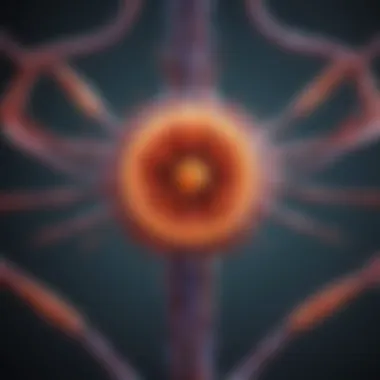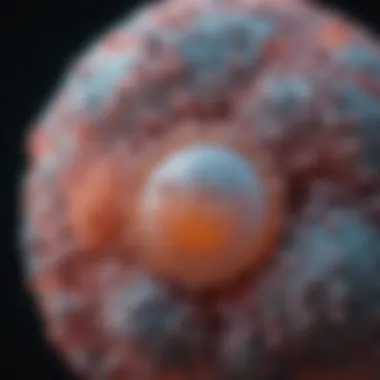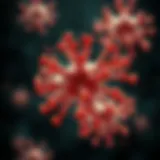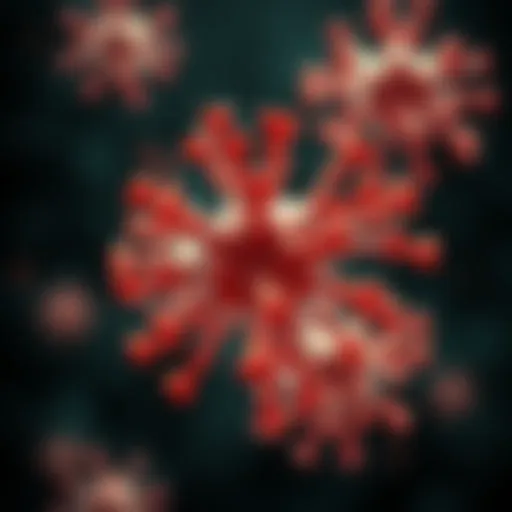Understanding RET Fusion Positive Thyroid Cancer


Intro
RET fusion positive thyroid cancer is an important area of study in cancer research. These cancers are driven by specific genetic mutations that lead to uncontrolled cell growth. Understanding this subtype is critical, as it can differ significantly from other forms of thyroid cancer in characteristics, diagnosis, and treatment approaches. This article will delve into the molecular mechanisms at play and how they affect clinical outcomes.
This exploration will provide a comprehensive overview of recent advancements within the field, particularly focusing on significant research trends and treatment strategies.
Key Concepts
Definition of the Main Idea
RET fusion positive thyroid cancer refers to the presence of RET gene fusions. These genetic alterations can activate pathways that promote tumor growth. This type of cancer is often diagnosed at a younger age and can present differently compared to other thyroid cancers, such as papillary or follicular thyroid carcinoma. Recognizing these differences is vital for accurate diagnosis and effective treatment.
Overview of Scientific Principles
The primary scientific principle involves understanding how genomic alterations contribute to the transformation of normal thyroid cells into cancerous ones. RET gene fusions are a result of chromosomal rearrangements. These rearrangements can cause the RET gene to fuse with other genes, leading to the production of abnormal proteins that drive oncogenesis.
Key terms to grasp include:
- Oncogenic processes: Mechanisms through which normal cells become cancerous.
- Molecular profiling: Analysis of genetic material to understand cancer characteristics.
- Targeted therapies: Treatments designed to specifically target cancer cells with certain genetic markers.
Current Research Trends
Recent Studies and Findings
Recent research has focused on identifying genetic alterations beyond RET fusions in these cancers. Studies show that co-existing mutations can impact clinical behavior and responses to treatment. Investigators are also exploring biomarkers that can enhance diagnostic precision.
Significant Breakthroughs in the Field
Advancements in targeted therapies have been notable. Drugs such as selpercatinib and pralsetinib specifically target RET alterations and have shown promising results in clinical trials. These treatments have changed the paradigm of how RET fusion positive thyroid cancer is managed, providing options that were previously unavailable.
"Targeted therapies have the potential to significantly improve outcomes for patients with RET fusion positive thyroid cancers."
"Targeted therapies have the potential to significantly improve outcomes for patients with RET fusion positive thyroid cancers."
Preamble to RET Fusion Positive Thyroid Cancer
RET fusion positive thyroid cancer signifies a significant advancement in our understanding of thyroid malignancies. The designation refers to thyroid cancers exhibiting genetic alterations particularly involving the RET gene. Grasping this topic is crucial due to its implications for diagnosis, treatment, and research. An exploration of RET fusion presents an opportunity to uncover unique molecular mechanisms at play in tumorigenesis, offering potential pathways for therapeutic interventions.
Overview of Thyroid Cancer
Thyroid cancer has various forms, with papillary thyroid carcinoma, follicular thyroid carcinoma, medullary thyroid carcinoma, and anaplastic thyroid carcinoma being the most prominent. Among these, the incidence of RET fusion positive thyroid cancer has been increasing. This subtype is particularly associated with unique genetic profile, making it necessary for clinicians and researchers to understand its features.
Thyroid cancers tend to display a range of symptoms, often related to the thyroid gland's position and function. Common clinical presentations include nodules, changes in voice, and neck swelling. Yet, these indicators can be misleading. Early detection through imaging and biopsy is critical for improving prognosis.
Importance of Genetic Alterations
Genetic alterations play an essential role in the pathogenesis of RET fusion positive thyroid cancer. The RET gene is crucial for normal cell signaling and function, but when it becomes fused with other genes, it can lead to uncontrolled cell growth.
Changes such as this reflect a shift toward precision medicine. Understanding the specific genetic alterations in tumors can help tailor treatments to individual patients. Different RET fusion variants, such as CLIP1-RET and KIF5B-RET, may influence treatment responsiveness and overall prognosis.
The discovery of RET fusions highlights the intersection of genetics and oncology, prompting enhanced screening protocols and targeted therapies.
The discovery of RET fusions highlights the intersection of genetics and oncology, prompting enhanced screening protocols and targeted therapies.
Molecular Biology of RET Fusion
Mechanisms of RET Fusion Formation
RET fusions occur through various mechanisms, primarily involving chromosomal rearrangements. These rearrangements typically lead to the anomalous fusion of the RET gene with other genes, disrupting normal gene function. The two most common methods for these alterations include translocation and inversion.
When a RET gene fuses with another gene, it often forms an active oncogene, promoting uncontrolled cell growth. This process may involve different interactions between the involved chromosomal segments, leading to distinct fusion variants. Understanding how these fusions form enables the identification of potential therapeutic targets for intervention.
Types of RET Fusion Variants
The identification of RET fusion variants is essential in grasping the complexities of this cancer type. They serve as unique biomarkers not only for diagnosis but also for tailoring treatment regimens. Below are some notable RET fusion variants.
CLIP1-RET
The CLIP1-RET fusion results from the fusion of the RET gene with the CLIP1 gene, producing an active oncogenic protein. This variant is particularly significant due to its prevalence among RET fusion-positive thyroid cancers. The key characteristic of CLIP1-RET is its contribution to enhanced signaling pathways that promote cell proliferation and survival.
Moreover, the presence of this fusion can serve as a predictor of aggressive disease behavior. However, targeted therapies aimed at this variant are still under investigation, and more research is needed to define its efficacy fully.
KIF5B-RET
The KIF5B-RET fusion is another major variant arising from the RET gene's fusion with the KIF5B gene. This fusion has gained attention due to its association with a specific subset of thyroid cancers. Its key characteristic lies in its unique coding sequence, which alters the RET protein's signaling capabilities.
Overall, KIF5B-RET is recognized as a prominent target for therapeutic intervention. It holds potential advantages, such as responsiveness to RET inhibitors. Still, its clinical implications remain to be fully understood, necessitating further studies.


Others
Several other RET fusion variants exist beyond CLIP1-RET and KIF5B-RET. These lesser-known fusions contribute to the diverse biology of RET fusion positive thyroid cancer. Each fusion brings unique characteristics, often associated with different clinical outcomes and responses to treatment.
Understanding these varieties broadens the scope of diagnostic capabilities and potential treatments. However, information on these fusions remains limited, and ongoing research aims to uncover their implications further.
The exploration of RET fusion variants is crucial for developing personalized treatment strategies for thyroid cancer patients.
The exploration of RET fusion variants is crucial for developing personalized treatment strategies for thyroid cancer patients.
In summary, the molecular biology behind RET fusions reveals a complex interaction of genetic alterations driving thyroid cancer progression. By understanding the mechanisms and types of RET fusions, healthcare professionals can enhance diagnostic accuracy and strengthen therapeutic approaches, ultimately improving patient outcomes.
Epidemiology of RET Fusion Positive Thyroid Cancer
The epidemiology of RET fusion positive thyroid cancer is essential for understanding its distribution and impact on various populations. This topic highlights the frequency and demographic characteristics of these cancers, providing a necessary context for both researchers and healthcare professionals. By examining prevalence and risk factors, we can better ascertain the effective strategies for management and intervention in this specific subset of thyroid malignancies.
Prevalence Across Populations
The prevalence of RET fusion positive thyroid cancer varies significantly across different populations. Research indicates that this type of cancer is more common in certain ethnic groups, which may be linked to genetic predispositions. For instance, studies show higher incidence rates in populations from Asian countries when compared to those in Western nations. The involvement of RET fusions signifies the vital role of genetic analysis in characterizing thyroid cancers, making it clear that efforts should include routine screenings based on demographic factors.
Associated Risk Factors
Family History
Family history is a notable aspect influencing the risk of developing RET fusion positive thyroid cancer. Genetic predisposition plays a crucial role, as the presence of this cancer type often runs in families. Individuals with relatives affected by thyroid cancers related to RET fusions have a heightened risk of being diagnosed themselves. This hereditary characteristic underscores the importance of genetic counseling for individuals with a significant family history of thyroid disease. While family history is a commonly accepted risk factor, it also presents a challenge; not everyone with a family history will develop the disease, leading to ambiguities in risk assessments.
Environmental Factors
Environmental factors are another critical component influencing the epidemiology of RET fusion positive thyroid cancer. Exposure to specific environmental elements, including radiation and certain chemicals, may increase the risk of developing these malignancies. Research has suggested that regions with higher levels of environmental pollutants may see correspondingly higher rates of RET fusion alterations in thyroid cancer. However, determining the direct causal relationship requires extensive studies, thus adding layers of complexity to this area of research. Understanding the implications of environmental factors is beneficial as it may lead to preventive strategies aimed at reducing exposure in high-risk areas, ultimately aiming to decrease the incidence of this cancer.
Clinical Features and Diagnosis
Understanding the clinical features and diagnostic approaches related to RET fusion positive thyroid cancer is crucial for effective patient management. This section highlights the symptoms that may present in affected individuals and the diagnostic methods that facilitate early detection and accurate characterization of the disease.
Symptoms of RET Fusion Positive Thyroid Cancer
RET fusion positive thyroid cancer can manifest through various symptoms, often overlapping with classic thyroid cancer signs. Commonly reported symptoms include:
- Thyroid Nodules: Many patients present with palpable nodules in the thyroid region. The presence of nodules may raise suspicion but does not confirm malignancy.
- Swelling in the Neck: This often indicates lymphadenopathy or tumor expansion locally.
- Hoarseness or Voice Changes: The proximity of the thyroid gland to the laryngeal nerve means certain tumors can compress this nerve, leading to vocal changes.
- Difficulty Swallowing or Breathing: Advanced cases may put pressure on the trachea or esophagus.
These symptoms warrant further investigation, as they can vary significantly among patients. Early identification of these clinical features leads to timely intervention and can improve clinical outcomes.
Diagnostic Approaches
Accurate diagnosis is essential for the management of RET fusion positive thyroid cancer. Two primary diagnostic methods are commonly employed: ultrasound imaging and fine needle aspiration. Each approach provides unique insights into the nature of the thyroid condition, facilitating informed decision-making for subsequent interventions.
Ultrasound Imaging
Ultrasound imaging serves as a pivotal initial step in evaluating thyroid nodules. This non-invasive technique allows clinicians to visualize thyroid structures clearly. One of the key characteristics of ultrasound is its ability to differentiate between solid and cystic nodules, which can be indicative of malignancy.
The benefits of using ultrasound in this context include:
- Real-Time Assessment: This imaging can be performed quickly at the clinic to evaluate nodular formations.
- Guidance for Procedures: It is often utilized to guide fine needle aspiration to ensure proper sampling of nodules.
However, ultrasound has limitations. While it is excellent for morphological assessment, it cannot determine the histological nature of lesions. Thus, it is an important diagnostic tool but must be accompanied by further testing for definitive results.
Fine Needle Aspiration
Fine needle aspiration (FNA) biopsy plays a critical role in the definitive diagnosis of thyroid cancer, including RET fusion positive cases. During this procedure, a thin needle is used to extract cells from the thyroid nodule. The key characteristic of FNA is its ability to provide material for cytological examination, allowing pathologists to assess cellularity and morphology.
This method has several advantages, such as:
- Minimally Invasive: FNA is generally well-tolerated and carries a low risk of complications.
- Rapid Results: This technique often allows for fast diagnosis, helping to expedite treatment decisions.
Nevertheless, FNA also has disadvantages. The procedure may produce inconclusive results, requiring repeat sampling in some cases to ensure accurate diagnosis. Additionally, the success of FNA largely depends on the operator's skill and the characteristics of the nodule being examined.
In summary, understanding the clinical features and utilizing appropriate diagnostic approaches are critical components in the management of RET fusion positive thyroid cancer. Timely and accurate identification of symptoms, coupled with effective diagnostic techniques, can significantly impact patient outcomes.
In summary, understanding the clinical features and utilizing appropriate diagnostic approaches are critical components in the management of RET fusion positive thyroid cancer. Timely and accurate identification of symptoms, coupled with effective diagnostic techniques, can significantly impact patient outcomes.
Pathological Evaluation
The evaluation process typically involves histological examination, which looks at the tissue structure and cellular characteristics. This evaluation helps identify specific cellular changes associated with RET fusions. By understanding these histological features, clinicians can predict the tumor's aggressiveness and potential for metastasis. Additionally, findings from pathological evaluation inform the choice of targeted therapies, making it essential for a comprehensive cancer management plan.
Histological Features
Histological features of RET fusion positive thyroid cancer often reveal distinct cellular patterns. Typically, these tumors exhibit a variant of papillary thyroid carcinoma and can show architectural patterns like follicular growth or solid tumors. The presence of certain cellular characteristics, such as nuclear atypia and mitotic activity, can indicate a more aggressive subtype.
Identifying these features is important for pathologists to classify tumors correctly. The histological profile not only provides insights into the tumor behavior but also helps in distinguishing RET fusion positive cases from other thyroid malignancies.


Molecular Testing Methods
Molecular testing methods are integral to diagnosing and managing RET fusion positive thyroid cancer. These techniques provide insights into the genetic alterations present in tumor samples. Two key methods include nucleic acid analysis and immunohistochemistry.
Nucleic Acid Analysis
Nucleic acid analysis involves examining the genetic material from tumor specimens. This method allows for the detection of RET gene fusions, which are critical for confirming a diagnosis of RET fusion positive thyroid cancer. One key characteristic that makes nucleic acid analysis particularly beneficial is its sensitivity in identifying various fusion variants.
A unique aspect of this analysis is its ability to provide detailed information about the specific fusion partners involved. Understanding these partners helps define potential therapeutic targets and is vital in the context of personalized medicine. However, one disadvantage is that this analysis may require sophisticated technology and expertise, which may not be available in all clinical settings.
Immunohistochemistry
Immunohistochemistry (IHC) is another key method used in the pathological evaluation of RET fusion positive thyroid cancer. This technique utilizes antibodies to detect specific proteins associated with RET fusions in tumor tissues. The main characteristic that makes IHC a popular choice is its ability to provide a visual representation of protein expression patterns in the cells.
One unique feature of IHC is its usefulness in identifying downstream signaling pathways that may be activated by RET fusions. This insight can be crucial in developing targeted therapies. However, IHC can be influenced by various factors like tissue preservation and antibody specificity, which may affect the reliability of results.
Therapeutic Strategies
Therapeutic strategies for RET fusion positive thyroid cancer are critical in managing this specific subtype of thyroid malignancies. The significance lies in the tailored approaches that address the unique genetic alterations present in these cancers. Effective treatment methods can enhance patient outcomes, particularly when addressing the challenges posed by RET fusions. Focused interventions create a more comprehensive framework for patient management, ensuring that various aspects of the disease are addressed meticulously.
Surgical Interventions
Surgical interventions play a pivotal role in the management of RET fusion positive thyroid cancer. They are often considered the first line of action for patients diagnosed with this condition.
Total Thyroidectomy
Total thyroidectomy involves the surgical removal of the entire thyroid gland. This procedure is particularly important for patients with RET fusion positive thyroid cancer due to its effectiveness in minimizing the risk of disease recurrence. The key characteristic of total thyroidectomy is its potential for complete tumor resection, which provides a definitive treatment option.
The unique feature of total thyroidectomy is its ability to enable thorough pathological assessment post-surgery, which aids in determining tumor characteristics and guiding further treatment if necessary. While total thyroidectomy offers several advantages, including lower recurrence rates, it also comes with disadvantages such as lifelong dependence on thyroid hormone replacement therapy.
Lymph Node Dissection
Lymph node dissection is another critical surgical intervention. It focuses on removing potentially affected lymph nodes to assess and manage the spread of cancer effectively. The key characteristic of lymph node dissection is its role in staging the disease and informing subsequent therapeutic decisions.
The unique feature of this procedure is that it allows for targeted treatment of locoregional disease, which can significantly improve overall prognosis. However, lymph node dissection may lead to complications such as nerve injury or swelling, which must be weighed against the benefits of improved staging and treatment potential.
Targeted Therapies
Targeted therapies represent a remarkable advancement in treating RET fusion positive thyroid cancer. They are designed specifically to combat the molecular targets associated with the disease.
RET Inhibitors
RET inhibitors are a class of drugs specifically designed to inhibit the RET protein, which plays a crucial role in oncogenesis for RET fusion positive cancers. The main characteristic of RET inhibitors is their selectivity, which allows them to target cancerous cells while sparing normal tissue. This characteristic is beneficial as it minimizes side effects compared to traditional chemotherapy.
The unique feature of RET inhibitors lies in their ability to generate significant response rates in patients, making them a promising choice in this article's context. However, one must consider the potential for resistance, necessitating ongoing research and monitoring.
Combination Strategies
Combination strategies involve the use of RET inhibitors alongside other therapeutic modalities, such as chemotherapy or immunotherapy. This approach aims to enhance efficacy and prevent resistance mechanisms that might occur with monotherapy.
The key characteristic of combination strategies is their flexibility in addressing the disease from multiple angles. Such strategies are beneficial for patients who may not respond adequately to single-agent therapies. The unique feature is the potential for synergistic effects, which can amplify treatment outcomes. Nonetheless, combination strategies may also increase the risk of adverse effects, requiring careful management and patient monitoring.
Current Research Trends
Research into RET fusion positive thyroid cancer is rapidly evolving, driven by advances in genetic sequencing and molecular biology. Understanding these trends is critical for developing more effective diagnostics and therapies. This section highlights the significance of ongoing studies, focusing on two main themes: clinical trials and the discovery of new biomarkers.
Clinical Trials
Clinical trials are fundamental in assessing the safety and efficacy of new treatment strategies. In the context of RET fusion positive thyroid cancer, these trials focus on evaluating targeted therapies — particularly RET inhibitors such as Selpercatinib and Pralsetinib. These medications are designed to specifically target and inhibit the activity of the oncogenic RET fusion proteins, aiming to slow down or stop tumor growth.
Moreover, clinical trials also explore combination therapies, assessing how these can enhance treatment outcomes. Participants in these trials often have access to cutting-edge therapeutic options that may not be available outside the research setting.
Clinical trials play a pivotal role in translating laboratory findings into clinical applications, shaping the future of personalized treatment for RET fusion positive thyroid cancer.
Clinical trials play a pivotal role in translating laboratory findings into clinical applications, shaping the future of personalized treatment for RET fusion positive thyroid cancer.
New Biomarkers
The quest for new biomarkers is another vital area of current research. Biomarkers are biological indicators that can help in diagnosing cancer, predicting its course, and tailoring treatments.
In RET fusion positive thyroid cancer, identifying specific molecular signatures linked to RET fusions can lead to improved diagnostic accuracy and better patient stratification for therapies. The emergence of next-generation sequencing technology facilitates this process, providing a more comprehensive understanding of the cancer's genomic landscape.
Some biomarkers may also indicate response to therapies or help predict prognosis. For example, mutations in the BRAF gene may co-occur with RET fusions and could influence treatment approaches. As research progresses, these insights will likely enhance clinical decision-making and promote personalized approaches to patient management.
In summary, the trends in research for RET fusion positive thyroid cancer are shaping the future of oncology, leading to significant advancements in how we understand and treat this complex disease. Engaging with clinical trials and exploring new biomarkers are essential steps towards personalized medicine in oncology.
Future Directions in Research


Research in RET fusion positive thyroid cancer is evolving rapidly. Understanding the future directions in this field is crucial for advancing therapeutic approaches and improving patient outcomes. The exploration of personalized medicine and resistance mechanisms stands out as pivotal factors in this context.
Potential for Personalized Medicine
Personalized medicine refers to tailoring medical treatment to individual characteristics. This approach offers significant promise in the realm of RET fusion positive thyroid cancer. As genetic alterations can vary greatly among patients, personalized strategies may enhance treatment efficacy.
- Targeted Therapies: Since RET fusion is a specific genetic alteration, targeted therapies that focus on the RET pathway could be more effective. Current studies are investigating RET inhibitors like Selpercatinib and Pralsetinib, which have shown promise in clinical trials.
- Biomarker Identification: Developing reliable biomarkers will allow for better patient stratification. Identifying patients likely to benefit from specific therapies is essential.
- Treatment Customization: By evaluating individual tumor genomics, oncologists can design treatment regimens that are unique to the patient’s cancer profile.
Overall, personalized medicine is essential for improving treatment precision and outcomes in RET fusion positive thyroid cancer patients.
Exploring Resistance Mechanisms
Despite advancements in targeted therapies, resistance to treatment can develop, complicating management strategies. Understanding these resistance mechanisms is a critical aspect of future research in RET fusion positive thyroid cancer.
- Types of Resistance: Resistance can be primary or acquired. Primary resistance occurs when tumors do not respond to therapy from the outset. Acquired resistance develops after initial treatment success. Understanding these dynamics is vital for improving therapeutic strategies.
- Molecular Mechanisms: Research is ongoing to elucidate the molecular pathways that contribute to resistance. Alterations in downstream signaling pathways, for example, may render therapies ineffective.
- Combination Therapies: Combining different therapeutic agents could potentially circumvent resistance. Ongoing studies are examining whether pairing RET inhibitors with other targeted treatments enhances efficacy and reduces resistance.
"The future of RET fusion positive thyroid cancer treatment hinges on personalized strategies and a deep understanding of resistance mechanisms. Only through rigorous investigation can we hope to improve patient outcomes effectively."
"The future of RET fusion positive thyroid cancer treatment hinges on personalized strategies and a deep understanding of resistance mechanisms. Only through rigorous investigation can we hope to improve patient outcomes effectively."
This article has provided essential insights into future research directions, emphasizing the importance of personalized medicine and understanding resistance in RET fusion positive thyroid cancer.
Patient Prognosis and Management
Understanding the prognosis and management of RET fusion positive thyroid cancer is crucial for optimizing patient outcomes. Patients diagnosed with this specific cancer type often face unique challenges that require tailored strategies. Through thorough evaluation of survival rates and effective long-term monitoring approaches, both healthcare professionals and patients can make informed decisions regarding treatment and ongoing care.
Survival Rates
The survival rates for RET fusion positive thyroid cancer can vary significantly based on several factors including patient age, tumor stage, and the presence of specific genetic mutations. Generally, studies indicate that patients with RET fusions have a more favorable prognosis compared to those with other forms of thyroid cancer. However, precise survival statistics depend on the individual’s overall health and response to treatment.
"Survival outcomes are often linked to early detection and treatment plans that incorporate targeted therapies."
"Survival outcomes are often linked to early detection and treatment plans that incorporate targeted therapies."
Several factors contribute to the survival outcomes of patients:
- Early Diagnosis: Patients diagnosed at an earlier stage often demonstrate better survival rates.
- Treatment Response: Those who respond well to targeted therapies exhibit more favorable survival.
- Genetic Profiling: Understanding specific RET variants can inform prognosis, guiding treatment options.
Healthcare providers strive to communicate survival expectations clearly, providing emotional and psychological support to patients and their families throughout the treatment process.
Long-Term Monitoring
Long-term monitoring is essential for patients with RET fusion positive thyroid cancer to detect any recurrence or metastasis early. This involves regular follow-up visits and diagnostic tests tailored to the individual’s needs. Monitoring strategies can include:
- Thyroid Function Tests: Regular assessments of thyroid levels help evaluate how well the thyroid is functioning following treatment.
- Imaging Studies: Ultrasounds and CT scans may be performed periodically to assess for any changes in the thyroid or surrounding lymph nodes.
- Serum Tumor Markers: Levels of specific markers can be monitored to identify potential signs of recurrence or disease progression.
Maintaining an open line of communication between healthcare providers and patients is also fundamental. Patients should be educated on the signs of recurrence and the importance of adhering to follow-up care. The ultimate goal is to create a proactive management plan that enhances the quality of life while optimizing health outcomes.
Monitoring strategies must be adaptable, considering the patient’s evolving needs and medical advancements in treatment approaches.
Ethical Considerations
Ethical considerations are paramount in the discussion of RET fusion positive thyroid cancer. With the advances in genetic testing and treatment options, several ethical dilemmas arise that necessitate careful reflection and responsible approaches. These could shape patient outcomes and influence public trust in healthcare practices.
One central issue is the impact of genetic testing. The ability to identify RET fusions can prompt questions about accessibility, affordability, and the potential for discrimination. These issues affect diverse populations, where disparities in healthcare equity can lead to unequal opportunities for diagnosis or treatment. Given that early detection is vital for improving prognosis, ensuring that all patients receive equitable care becomes crucial.
Another pressing concern relates to genome editing. Exploring the potential for gene editing to correct or mitigate the effects of RET fusions raises a host of ethical questions, including its long-term consequences on individuals and communities. It reflects on the moral obligations to ensure that this technology does not inadvertently harm patients or lead to unintended consequences.
Additionally, the need for informed consent is significant. Patients must fully understand what genetic testing entails, including its risks and benefits. This transparency fosters trust and empowers individuals in making decisions regarding their health. The complexities inherent in genetic information must be communicated clearly to avoid misunderstandings that could affect patients’ choices.
As research and treatment evolve, it becomes essential to prioritise ethical guidelines that safeguard patient rights and promote responsible innovations in thyroid cancer care.
"Addressing ethical considerations in cancer genetics is not just about compliance. It’s about nurturing a culture of trust and responsibility that benefits patients and society."
"Addressing ethical considerations in cancer genetics is not just about compliance. It’s about nurturing a culture of trust and responsibility that benefits patients and society."
Genome Editing and Its Implications
The advent of technologies such as CRISPR has opened new avenues for treating RET fusion positive thyroid cancer. Genome editing holds promise as a potential therapeutic strategy by offering the possibility to correct mutations or modify gene expressions directly involved in oncogenesis. However, these approaches are accompanied by significant ethical implications.
The ability to edit genes carries the potential for long-lasting effects on individuals and perhaps future generations. One question that arises is whether it is ethical to alter a patient’s genetic makeup, particularly when the long-term consequences remain uncertain. Furthermore, there is the risk of exacerbating existing health disparities in access to such advanced treatments.
Moreover, considerations must be given to the potential for off-target effects, which can result in unintended mutations. This compels the scientific community to establish rigorous testing and monitoring protocols to ensure that genome editing remains safe and effective.
Informed Consent in Genetic Testing
Informed consent is the cornerstone of ethical medical practice, especially in the field of genetic testing for conditions such as RET fusion positive thyroid cancer. Patients must be well-informed about the nature of the tests, their purposes, and potential outcomes to make conscious decisions about undergoing testing.
Critical elements of the informed consent process include:
- Comprehensive explanations of the testing process and what it entails.
- Clear communication of the benefits, limitations, and potential risks associated with the results.
- Discussion on how results may influence treatment options and management strategies.
The complexity of genetic information presents unique challenges. Education resources must be tailored to accommodate varying levels of understanding among patients. This is essential to ensure that consent is not just a formality but a genuine agreement made with a clear comprehension of implications.
Furthermore, obtaining informed consent should be an ongoing process, allowing for patient questions and discussions as new information becomes available.







